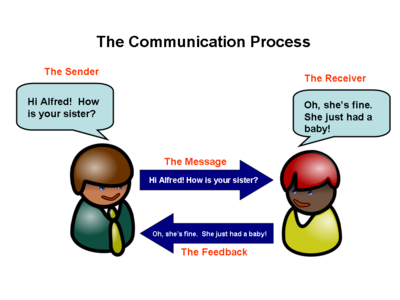Life Skills Development/Module Three/Unit 1: The Approach to Communication/Process
Topic 1:
Contents
Content
|
Learners should be able to:
|
Standing in a circle, one learner decides on a short message and shares it in a whisper with the person standing next to him/her. This process continues until the message comes back to the learner on his/her other side who will share the message with the entire group. The learner will then recite the original message sent. Participants will share the different messages they heard as it was passed around the circle. Learners will engage in discussions on how messages can be distorted.
|
Process of Communication
Communication is interactive. The understanding of the message depends on the context in which ideas and feelings are shared.
Concepts of Communication
There are four main skills in the communication process:
1.Listening - an active process involving selecting, attending to, creating meaning from, remembering and responding to verbal and non-verbal messages.
There are four levels of listening a) Non-listening - making no effort to listen
b) Marginal listening - is easily distracted
c) Evaluative listening - focuses on content but disregards the speakers feeling
d) Active listening - pays close attention and gives verbal and non-verbal feedback.
2.Questioning - check facts, gain further information and build rapport to explore opinions or attitudes.
3.Clarifying - the process of simplifying, explaining, spelling out, shedding light on or making clear the message received.
4.Responding - an appropriate reaction to the message received.
Communication can help you recognize and realize your potential. Hence great importance has been placed on the process and its use.
Why then is the process of communication so important?
The process of communication is important as human beings need to make sense of their environment and share that sense with others by creating meaning through the use of verbal and non-verbal messages. Communication touches every aspect of our lives. It is vital for our well being and is necessary to develop quality interpersonal and intrapersonal relationships. Learning how to understand and improve communication will improve relationships with family, friends, colleagues and loved ones that will ultimately enhance physical and emotional health and well being.
Viewing Communication channel
The image below depicts the communication process
The image illustrates the following:
- Sender - person who is sending the message to another person
- Receiver - person who recieves the message from the sender
- Encode - is a technique by which the senders uses to send the message into language, symbols or signals
- Message - is the idea or information that the sender wants to pass on to the reciever
- Channel- is the means by which the message is sent through either verbal or non-verbal
- Decode - the reciever interprates and translate the senders message
- Responding- is the way in which the sender or reciever reacts to the message
- Feedback - is the reciever's reaction to the message recieved, this may be verbal or non verbal
|
Listen, Pair and Share Learners will listen to music/poem/song. In pairs they will discuss the messages heard and report on their understanding and feeling about the message and how it affects them individually. The lyrics of one suggested song[1]
|
|
You may choose to communicate your feelings by writing. a) Write a letter to friend expressing how you feel about the condition in which your shoes that you lent him/her was returned. or b) Write a poem or song to someone you have a romantic interest in expressing your desire. Discuss with the recipient the impact of the process.
|
|
Communication is a complex process of creating and sharing meaning that involves at least two persons with a common understanding of the message. Communication involves a process of sending and receiving of messages. The breakdown in this process negatively affects the quality of relatinships. The elements of communication involves:
|
|
Evaluate your progress. 1. Discuss with another learner what you have learnt about the process of communication and how it has impacted on your interaction with others. Identify the methods that are least effective and identify strategies that can be employed to improve this. Identify your strengths and discuss why you have been so successful using that process. |
Peer assessment
Presentations, discussions and dramatizations
Use role play to familiarize your peers with your understanding and experiences in the communication process.
Discuss with your peers how they feel about how you communicate with them.
Present scenarios of your experiences and share your approach to problem solving.
Support Materials
- Handouts
- Videos
- Skits
- Power point presentation
- Comics
- Animations
